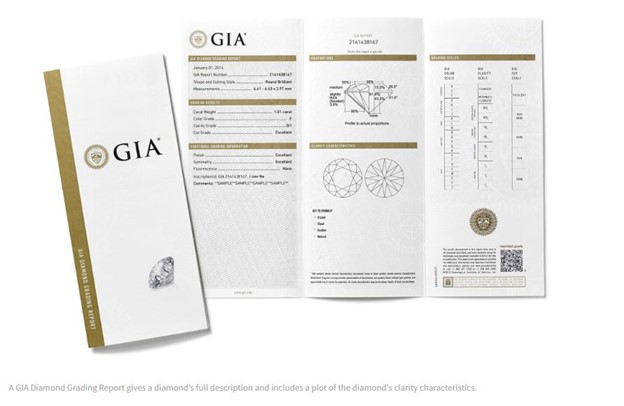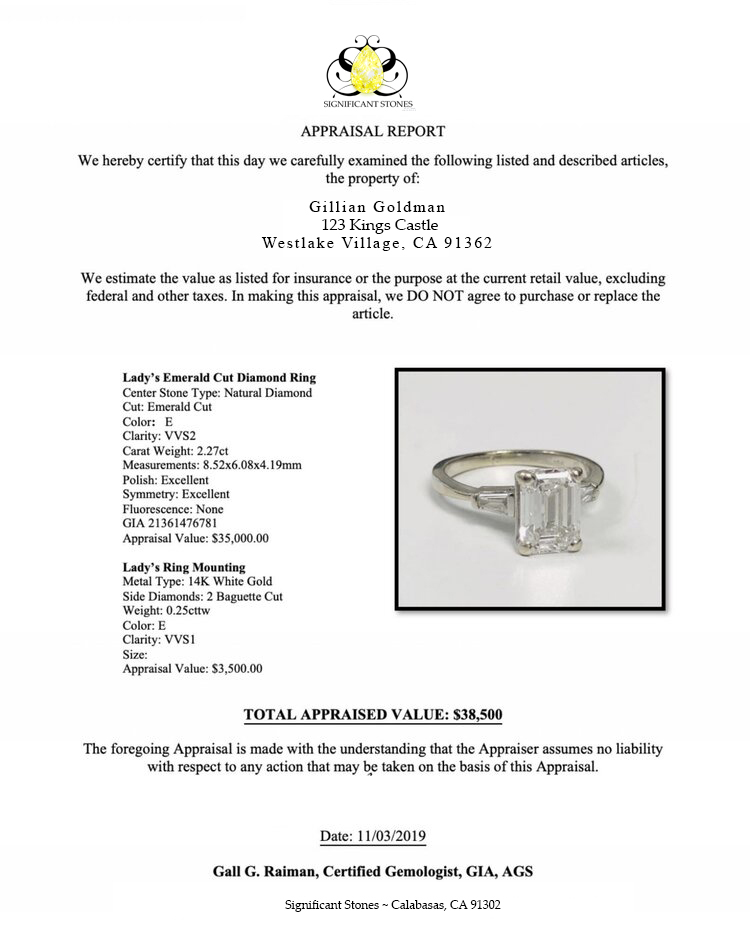Gemological Laboratory Grading Reports
Why is it important to buy a diamond or gemstone with a grading report?
There are many gemological labs in the world. Some are highly respected, and others are not. One of the most highly respected labs in the world is the Gemological Institute of America (GIA). Stones are submitted from all over the world to GIA for grading of diamonds and colored gemstones. Another reputable grading lab is AGSL (American Gem Society Laboratories). Lab reports from AGSL are also very highly respected. It was announced in the latter part of 2022 that the AGSL Laboratories will be closing and will be
bringing their expertise to GIA, which has always been their “sister” lab as they were both started by the same man, Robert M. Shipley. As of 2023, some elements of the AGSL report will be offered as an optional, additional report to accompany a GIA lab report. The American Gem Society will continue to carry on the work of its mission.

Why is it important to buy a diamond or gemstone with a laboratory grading report?
GIA Grading Process
- GIA is an independent lab that analyzes the characteristics of diamonds and gemstones.
- The lab issues a detailed report with a unique number describing the specific stone.
- The number of the report and its information is maintained by GIA including additional data gathered that is not included in the report.
- GIA offers a laser inscription, on the gemstone itself for the purpose of ease in identifying the gemstone.
Why do you need a grading report?
- A grading report indicates if the stone is natural, lab-grown, treated, a simulation or imitation.
- A grading report states the stone’s cut, clarity, color and carat weight.
- A grading report indicates the stone’s clarity characteristics and maps them – like a unique figure print.
- If laser inscribed, the grading report will state the inscription number.
- Each grading report identifies a specific diamond or gemstone.
- A grading report from a reputable gemological laboratory helps determine the gemstone’s value.
There are many diamonds and gemstones that do not have a laboratory grading report, or have a report from a lab that is not highly respected. Often (although there are always exceptions), the reason a diamond does not have an accompanying grading report from a respected laboratory is because it would not get a good report so a stone you are considering that does not have a report should get its due diligence. If, upon inspection of the stone it seems that it could possibly get a good report but was never sent in for whatever reason, it can be sent in for evaluation at any time. However, the stone does need to be a loose stone; it cannot be mounted. Sometimes a stone will have a report, but it is issued by a gemological laboratory that is not respected because the lab is known for grading stones not to the standard, so often the color, clarity, and other details of the stone will be graded higher than it actually is. Additionally, these labs are often for-profit labs so they are not impartial; they have a vested interest in producing reports with grading that is inaccurate and inflates the quality of the diamond. Jewelers will sell stones with these reports to unsuspecting customers who do not realize they are not respected reports with accurate, industry standard grading. Diamonds with accompanying reports issued by respected labs will command a higher price because they are more valuable stones, yet jewelers who try to pass off stones from “lesser” labs still charge the premium to the unsuspecting customer.
GIA standards
Through research, education, and unbiased gem grading and analysis, GIA strives to protect the gemstone and jewelry buying public by setting global quality standards.
Appraisals
WHY IS IT IMPORTANT TO APPRAISE YOUR FAMILY JEWELS?
In order to determine how much your gemstones or jewelry are worth, you need to have them evaluated. It’s extremely important to go to a professional that is fully knowledgeable on gemstones and jewelry, who can give you an accurate appraisal. Ideally the appraisal is based on your gemstone’s GIA grading report.
How Does an Appraisal valuate my Gemstone's Value?

GIA Grading Reports vs. Diamond Appraisals
Gemstone grading reports are completed by professional gemological labs, such as GIA (Gemological Institute of America), EGL (European Gemological Laboratory), IGI (International Gemological Institute) and AGS (American Gem Society).
One of the key differences between an appraisal and a grading report is that the grading certificate typically does not provide a monetary value, while an appraisal does. Appraisers do not examine gemstones or jewelry to the same depth as the gemologists behind gemstone grading reports and lab grading.
A final point to keep in mind: if you want to sell your gemstone or jewelry, an appraisal will tell you the value of the gemstone or jewelry, while a grading report will cover the characteristics of the gemstone alone.
Why should I get an appraisal?
When should I get my diamond appraised?
Another important occasion to get an appraisal is if you are considering selling, or similarly for tax purposes, for example if the gemstone or jewelry is included in an estate’s value.
It’s also important to note that you should get your gemstone or jewelry appraised about every five years. You always want to be sure that you have an accurate recorded value because the value of diamonds and other precious stones and metals increases over time.
The Diamond Appraisal Process:
General Condition Overview — A appraiser will visibly inspect the piece to assess the general condition, as well as to make sure the gemstone and or metals in the case of jewelry are genuine before evaluating further.
The 4C’s — The most important step of the process, is to analyze the characteristics of the gemstone including carat weight, color, clarity, and cut. In the case of jewelry the metal(s) that are used will be determined and characterized.
Description — After the examination, the appraiser will write a report, including all his or her findings and an estimated market value will be included.
